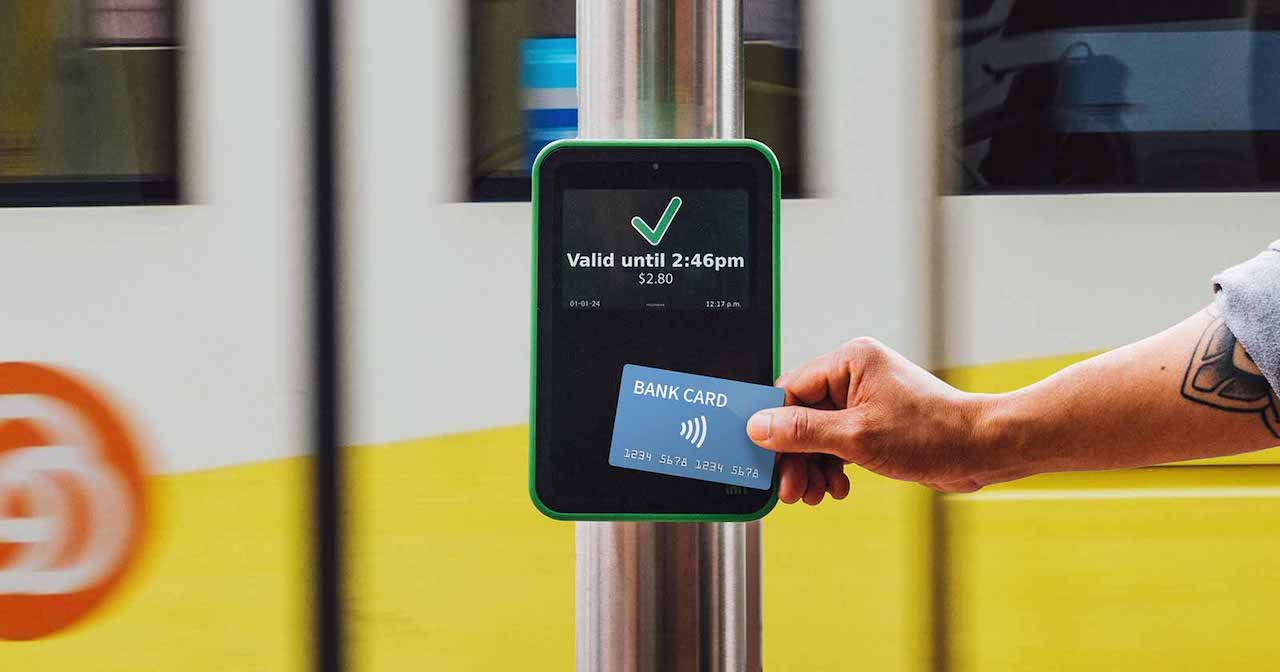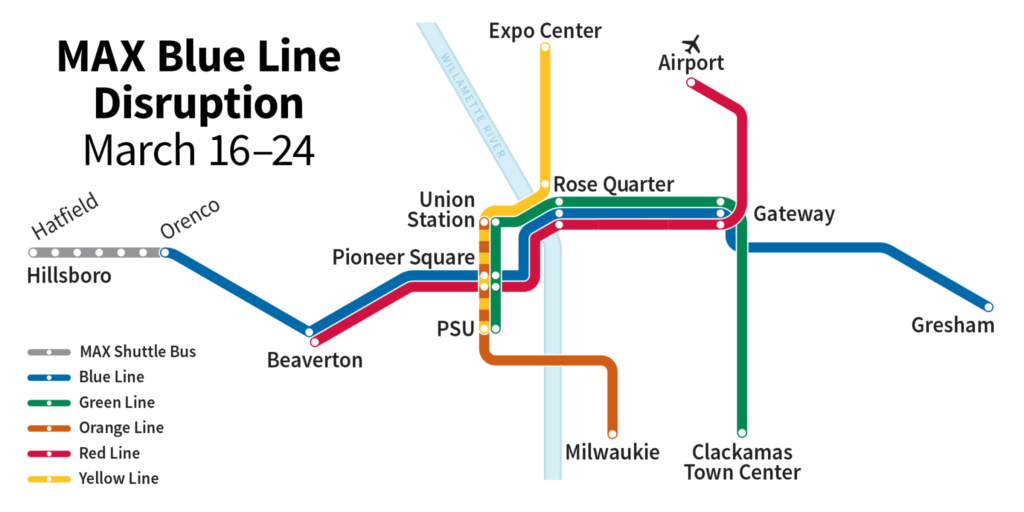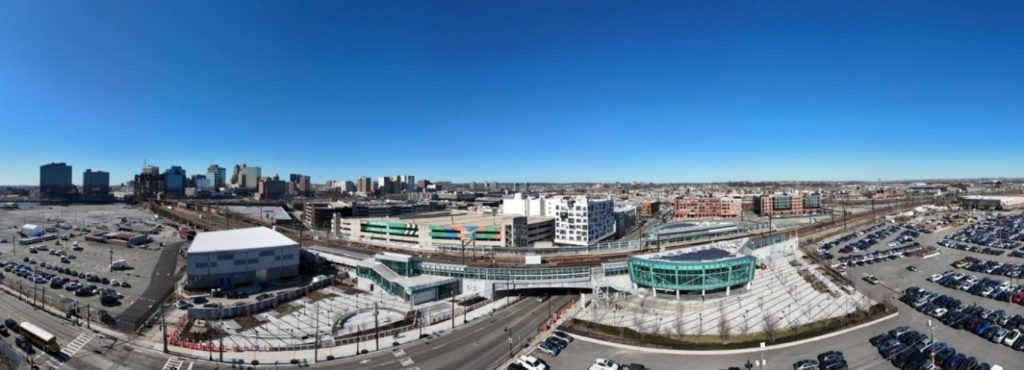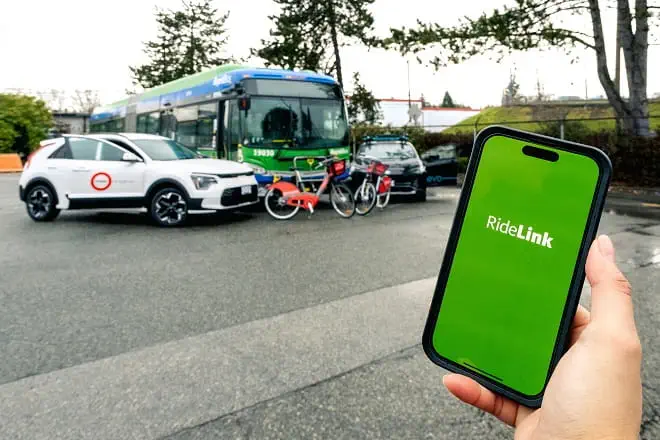
Transit Briefs: TriMet, NCTCOG, PANYNJ, Oregon Senate, TransLink, GCRTA
Written by Carolina Worrell, Senior Editor
TriMet photo
TriMet expands Hop Fastpass® benefits to contactless bank cards and announces that construction of it’s A Better Red MAX Extension and Reliability and Improvements Project is nearing the end. Also, the North Central Texas Council of Governments (NCTCOG) hires McKinsey & Company and InfraStrategies LLC to lead the strategic assessment of transit in Dallas-Fort Worth; the Port Authority of New York and New Jersey (PANYNJ) opens a new $47.2 million accessible station house at the PATH Harrison Station; the Oregon Senate passes a bill criminalizing the use of illicit drugs on public transportation; TransLink tests a new multi-modal smartphone app; and the Greater Cleveland Regional Transit Authority (GCRTA) is awarded $9.5 million for transit projects.
TriMet
TriMet recently announced that it has expanded its Hop Fastpass® benefits. When customers use their contactless bank card, mobile wallet or smartwatch to pay their fare—and ride regularly—they will automatically get the main benefit of a Hop Fastpass® card: earning a Month Pass as they ride, with free rides after reaching $100.
“With Hop, you’ll never pay more than the cost of a Day Pass in a single day and never pay more than the cost of a Month Pass in a single month,” TriMet stated in a release. “Just make sure you always tap with the same card—whether a physical payment card, a card stored in your mobile wallet, a device such as a smartwatch or your Hop card.”
Separately, TriMet announced that construction on the agency’s A Better Red Max Extension and Reliability Improvements Project, which will extend Red Line service to Hillsboro, is nearing the end.
According to the agency, the final planned disruption for the multi-year project will take place from Saturday, March 16, through Sunday, March 24, along a stretch of the MAX Blue Line in Hillsboro. Shuttle buses will serve closed stations between Orenco Station and Hatfield Government Center, allowing crews to finish signal work in and around the Fair Complex/Hillsboro Airport MAX Station, what will become the new end of the line for MAX Red Line trains beginning this summer.

The disruption, TriMet says, is essential to the 10-station extension of the MAX Red Line from Beaverton Transit Center to Fair Complex/Hillsboro Airport, opening in late August. The agency will complete the Hillsboro signal work this spring to provide time for operator training and to complete finishing touches on the project prior to the extension’s opening.
The upcoming March disruption will be limited to the MAX Blue Line in Hillsboro. For all other lines, trains will be running on their regular schedules and continue serving all of their stations. TriMet will have On-Street Customer Service personnel and other staff available to help riders make their connections during the disruption.
NCTCOG
The NCTCOG Executive Board on Feb. 21 approved two contracts with two consultants to help transportation managers, board members and elected officials develop a next generation transit system for the region.
McKinsey & Company and InfraStrategies LLC will be paid approximately $2.2 million to help design a system that accommodates the North Central Texas of the future. The Executive Board authorized payment of $980,000 to McKinsey and $1,212,200 to InfraStrategies. Two consultants, NCTCOG says, were chosen because they each offer different expertise implementing the seven distinct project tasks outlined in the proposal.
The Dallas-Fort Worth area is served by three existing public transportation providers: Dallas Area Rapid Transit (DART), Denton County Transportation Authority (DCTA) and Trinity Metro in Fort Worth. The 12-county metropolitan area has a population of more than 8 million people and is forecast to grow to more than 11 million by 2045, according to NCTCOG. “Much of the projected population surge is expected to occur outside existing transit authority service areas, requiring an innovative approach for moving people across the region in the future,” NCTCOG said.
The study to explore Regional Transit 2.0 “aims to examine crucial transportation investments that could accommodate the anticipated population growth and support sustainable development across the region while also serving cities that lack the sales tax capacity to join one of the three traditional transit providers,” NCTCOG said.
Thirteen DART member cities pay a one-cent sales tax to belong to the transit authority. The cities of Denton, Highland Village and Lewisville pay a half-cent sales tax to support DCTA. Trinity Metro has two member cities—Fort Worth and Blue Mound—that pay a half-cent sales tax. Grapevine pays three-eighths of a cent to support TEXRail commuter rail service. North Richland Hills also belongs to the partnership.
In developing a plan for transit through 2050, the Transit 2.0 study will:
- Develop a transit legislative program.
- Develop strategies to increase transit authority membership.
- Develop collaborations between existing transit authorities.
- Develop strategies for authority board partnerships and teamwork.
- Develop strategies for infill development.
- Review fare-collection strategies.
- Develop recommendations for the transit authority-member city paradox.
In a letter to members of the Regional Transportation Council, the mayors of 12 Dallas-Fort Worth area cities and the chair of Dallas Regional Mobility Coalition requested the RTC commit to examine how public transportation can evolve to meet the needs of the region.
“As member cities of a transit authority, we acknowledge and embrace that the growth of the region requires an efficient transit solution in order to provide predictable, cost effective, and reliable mobility for residents and businesses,” the letter stated. “We believe a comprehensive study is needed to assess the effectiveness of regional transit today and what regional transit should look like for the next 40 years.”
The transit authorities have a history of working together, including the following examples:
- DCTA’s A-train commuter rail and DART’s Green Line light rail meet in Carrollton.
- Trinity Metro and DART jointly own, operate and maintain the Trinity Railway Express commuter rail corridor between Dallas and Fort Worth.
- Trinity Metro and DART both offer rail service to Dallas Fort Worth International Airport.
- Trinity Metro and DCTA serve the vicinity of Alliance Airport with bus service.
The Transit 2.0 initiative, NCTCOG says, would enhance their partnership. There may be opportunities for the transit authorities to coordinate services, equipment and fare structures to create a more seamless experience for customers. Additionally, there should be an effort made to find economies of scale on expenses such as operating costs, additional capital costs and capital asset replacement.
“The current transit model has served this region well for 40 years. Our valued transit authorities have forged partnerships that have helped create a seamless experience for many North Texans,” said NCTCOG Director of Transportation Michael Morris, PE. “Our expansive growth gives us an opportunity to broaden our approach to moving people. Through close coordination, Dallas-Fort Worth has established a world-class transportation system that gives residents multiple options for how to move around the region. Transit 2.0 can ensure as we continue to grow in the coming decades, we are safely and efficiently connecting people to where they live, work and play.”
PANYNJ
PANYNJ on Feb. 21 announced that it has marked the completion of a new $47.2 million station house at the Harrison stop on the PATH commuter rail line “in the latest step toward Port Authority’s multi-facility modernization of the regional transit hub.”
The newly built 3,200-square-foot station house, which opened to the public at 3 p.m. Wednesday, Feb. 21, features new amenities, such as an elevator; a public plaza with seating; 82 bicycle parking spots along a 17,800-square-foot concourse; and a dedicated turnstile that accepts TAPP, PATH’s new contactless tap-and-go fare payment. Other turnstiles in the station house continue to accept existing PATH fare payment systems, such as SmartLink and MetroCard. The station house replacement project was funded partly by a $40.7 million Federal Transit Administration (FTA) grant.

According to PANYNJ, the original station house, built in 1936, had become outmoded and outdated by modern transportation needs and was razed to make way for a more modern and accessible replacement. The new facility was built with particular focus on resiliency and sustainability in adherence to PANYNJ’s rigorous standards. It was designed with enhanced flood protection from the nearby Passaic River, with the station house’s first level located above the flood plain. Water runoff will be collected and stored in water retention tanks for landscape irrigation.
The new station house, PANYNJ says, is the latest step forward in the agency’s $256 million transformation of the sprawling PATH Harrison station complex as a vital transportation hub in the region. The new facility located at the southwest corner of the Harrison station complex provides safe pedestrian access for the Harrison station without the need to cross the busy Frank E. Rodgers Boulevard. It complements a station house in the northeast section of the complex completed in 2018, and a second station house that opened in 2019 in the complex’s southeast section.
The expansion and modernization of the Harrison station complex was conceived as the town of Harrison’s development and population increased sharply in recent years, driven by quick and easy PATH service to and from New York City. In addition to service on the PATH Newark-World Trade Center line, the station provides connections to NJ TRANSIT buses, vehicle parking for commuters who wish to park and ride, and safe and secure free-to-use bicycle parking. At its peak, the station served 2.6 million passengers in pre-pandemic 2019, and has since rebounded to more than 1.7 million passengers in 2023.
In developing the new station house, PATH retained the original 1936 structure’s rich history and legacy by preserving and showcasing the original signage and numerous artifacts from the previous building. These include the installation of an interpretative display and a striking black-and-white aerial map in an area outside the entrance; bronze station signage letters; a Pennsylvania Railroad keystone, and a directional mosaic tile sign.
PANYNJ’s $256 million investment at Harrison encompasses extensive renovations, the three new station houses to improve egress, and the construction of a new substation that now powers the entire Harrison station complex. The new substation, which has been operational for a year, “ensures a dedicated power source for the large complex and was built to the agency’s stringent sustainability standards,” PANYNJ said.
“Our $256 million investment in the PATH Harrison station complex has turned an outmoded nearly-century old facility into an ultra-modern 21st century transit hub accessible to everyone,” said PANYNJ Executive Director Rick Cotton. “This expansion of the Harrison station that we are opening today advances our commitment to providing a modern 21st century customer experience at Port Authority facilities.”
“In the wake of Superstorm Sandy’s devastation, FTA contributed nearly $41 million through our emergency relief program to elevate and upgrade Harrison Station, ensuring resilience and improved accessibility,” said FTA Regional Administrator Michael Culotta, FTA. “This marks a transformative milestone for Harrison commuters.”
Oregon Senate
The Oregon Senate on Feb. 21 passed a bill criminalizing the use of illicit drugs on public transportation, according to a Salem Statesman Journal report.
According to the report, Senate Bill 1553, which now heads to the Oregon House for approval, would expand the “interfering with public transportation” crime to include ingesting, inhaling, igniting, injecting or consuming an illegal controlled substance on public transit vehicles or stations.
Doing so, the Salem Statesman Journal reports, would be a Class A misdemeanor punishable by a maximum of 364 days in jail, a $6,250 fine or both. “The bill would make the crime a drug-designated misdemeanor, meaning some of those convicted would have access to state-funded treatment.”
The bill, which passed with 27 votes in favor and three against, is one of the bills introduced in the short legislative session addressing use in Oregon, according to the report.
“Data from the Centers for Disease Control and Prevention this week revealed overdose deaths rose at a faster rate in Oregon than anywhere else in the country with a 41% increase in deaths between 2022 and 2023,” according to the report.
According to the report, the Oregon Transit Association (OTA) and Amalgamated Transit Union (ATU) testified in support of the bill earlier this month and called it a “necessary additional tool” to help transit agencies in the state address “widespread public use” of fentanyl and other drugs on public transportation.
According to testimony submitted by the OTA and ATU, the Lane Transit District recorded “130 incidents of drug use from January to October 2023,” the Salem Statesman Journal reported.
TriMet also submitted written testimony reporting an average of “more than 260 incident reports per month related to drugs and alcohol from October to December 2023.” The transit agency told lawmakers there was a 30% drop in riders feeling safe on its buses and trains, according to a survey, the Salem Statesman Journal reported.
TransLink
TransLink announced Feb. 21 that, along with Modo, Evo and Mobi by Rogers, it is testing a new app called RideLink that brings together transit, carshare and bikeshare services.
The app, which TransLink says makes planning, booking and paying for trips easier and more convenient, will be available to a limited number of people for a trial period and will “eliminate the need for using several different apps or websites to provide a truly multi-modal experience.”
The RideLink app features:
- Trip planning with transit, carshare, and bikeshare options with real-time information about vehicle and bike locations.
- Simple booking and payments for carshare and bikeshare services.
- Easy registration for Evo, Modo, and Mobi Bike services.
- An upgraded Compass Card to tap into transit, Evo, and Modo vehicles as well as Mobi Bikes at bikeshare stations.

According to TransLink, there are more than 200,000 registered users of bikeshare and carshare in Metro Vancouver and this new app will allow users to easily transfer between transit and each mode, with the goal of encouraging even more users to consider multi-modal journeys.
Data from TransLink’s first Shared Mobility Pilot shows that people are more likely to choose multi-modal travel when booking and payment options are simplified. In 2019, users received a Compass Card that worked on all four of these services, with one integrated billing account. According to the agency, 60% of participants said they reduced personal vehicle use, and 56% said they tried a new mode of transportation due to the card.
As part of the next phase of the trial, TransLink is accepting applications for 1,300 people to test the new multi-modal app. The agency will gather feedback from participants over a one-year period on the usability and ease of integration between the services. This feedback will determine whether the app will become permanent in the future.
To be eligible to participate in the trial, applicants must be at least 19 years old, have a valid driver’s license, a valid credit card, and a smartphone. Those who are interested in using multiple mobility services are more likely to be selected for the trial. Those interested in applying should visit TransLink’s website.
App development, beta testing, and integration is possible thanks to a $250,000 grant from the Federation of Canadian Municipalities through the Green Municipal Fund.
GCRTA
The Ohio Department of Transportation (ODOT) on Feb. 13 awarded $9.5 million in grant funds to GCRTA for transit projects as part of the $106 million in funding being awarded by ODOT to 383 transit projects throughout Ohio.
Nine million was awarded from the State Fiscal Year 2025 Ohio Transit Partnership Program (OTP2) for use towards the purchase of two new railcars, and LED signage at GCRTA HealthLine Stations.
“This is the fifth year that ODOT has awarded funding to the Railcar Replacement Program and brings the total ODOT funding to $42.1 million,” said GCRTA Deputy General Manager Engineering & Project Management Michael J. Schipper. “With this award GCRTA has now raised $363.5 million of the $393 million total program budget.”
GCRTA was also awarded another $400,000 from the Ohio Workforce Mobility Partnership Program for use towards bus shelter and bus stop improvements at up to 44 locations throughout Cuyahoga County.
“Funding opportunities such as these underscore the importance of public transportation to our region and subsequent investment in our communities. We are extremely pleased with the outcome of this round of funding and appreciate ODOT’s continued support of our Railcar Replacement Program, and assistance in improving our bus signage, shelters and stops throughout the Greater Cleveland area,” said GCRTA General Manager and CEO India L. Birdsong Terry.
The grant programs are funded through state general revenue funds and U.S. Department of Transportation funding awarded to ODOT.



